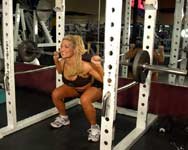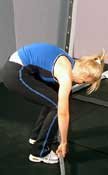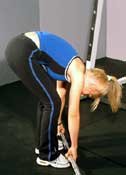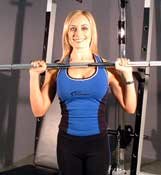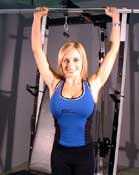Sorry its been awhile since my last article. I have a new son (Maxx), have expanded my business, competed 4 times, been through 2 seasons of sports with my older kids, and am now heading into the "harvest season" of the gym industry.
You already know a lot about me, but I want you to know the things I will discuss just don't work on me. I own a Powerhouse Gym in Kokomo, Indiana.
We have been training strongman here since the mid 90's. We refer to the place where we train as the Hall (my wife calls it the HOLE) ... or as some of the guys call it "The Powerhouse Gym Elite Training Hall".
We have produced more Pro Strongmen (7 in total) than any other gym in the country. 3 America's Strongest Man Titles have been held by our guys. That's just a bit of history, now lets get down to business!
Dynamic Effort
What does this mean exactly? Now you could go and read Dave Tate or Louis Simmons and they can explain it much better than I can, but I will give you the "Cliff note version".
Dynamic effort (DE) in my context means nothing more than SPEED. According to Dave Tate, "Dynamic effort is defined as lifting a non-maximal load with the greatest speed possible."
If you want to move big weights you must be fast. We use the DE day to teach the nervous system to fire quickly. Think of a lift you have missed.
Generally the bar just slows down and the weight stops moving and you miss the lift. Okay, you could need more MAX EFFORT (I'll get to this next article), but more likely you need more speed.
Template
My basic dynamic effort workout is this:
- Squat 6-9 sets of 2 reps
- Deadlift 6-10 singles
- Overhead press 4-7 sets of 3 reps
 Click Here For A Printable Log Of Basic DE Workout.
Click Here For A Printable Log Of Basic DE Workout.
These are the base 3 exercises, but they all have many variations. Depending on where your weakness lies you can vary the placing of each movement in the session.
For the last year I have really focused on my press, followed by the dead and finishing with the squat. I have changed it all around for the next 12 weeks and am starting with squats and then going to deads and ending with the press.
One more note before I dive into the squat. We use no equipment during this session; no belt, wraps, or straps. I will use Rehband sleeves that can be found at www.jackalsgym.com.
It is a high-quality neoprene material that adds support and keeps you warm. By not using any belt, I believe the dynamic effort enhances the core strength and in strongman if you have a weak core you will go nowhere!
Squat
The squat will be done to varying height boxes (12, 14, or 16 inches—depending on the trainee's height and whether you are hitting parallel or just below) or to a parallel rack height. The key on the squat is to keep everything tight during the decent.
Once you reach the bottom, relax only the hips for a split second and then ram the squat up as violently as possible.
Do the second rep the same way and then set it back into the rack. You should only rest 45-60 seconds between sets, so once the squatting begins you should be finished in around 10 minutes, give or take a minute.
How To Perform:
The weight used should vary but should never be more than 75% of one's max. We will wave our squat weights from 50-75%. I am around an 800-pound squatter, so I use between 400-600 pounds for speed if I am using only weight.
When doing the lift you should apply compensatory acceleration which means pushing against the weight with all the force you can muster on the 2 reps.
I want to apply 800 pounds worth of squat to the bar even when I am only squatting 400 pounds. Trust me when the bar gets moving fast, the plates will be singing to you!
No, that's not it on the squat. Once you have established the type of squat, the weight, you must then add accommodating resistance.
We do this by adding chains or bands. If you need bands, chains or about anything else that has to do with getting strong go to www.elitefts.com (this is Dave Tate's company). He and his staff will make sure you get the equipment and help you need. Shameless plug I know, but back to bands and chains.
You can add chains to the bar, bands, or both. Again variations are the key so mix it up and have fun. I currently use bands for 2 weeks, weight only for 1 week, and then chain for 2 weeks.
I have been training with these for about 4 years now and I will do some crazy stuff to myself, but for the rest of you I will give you a few guidelines.
First off if you are just using straight weight then just figure the percent you are using by your current max (500 lb squatter would use between 250 and 375). When adding chains do not include the chain weight in the percent that was set above. The chain will de-load at the bottom of the squat, but is felt at the top end.
Squatting with chain is more taxing than just weight at the top, but less in the hole! Dave Tate and Louis Simmons of Westside Barbell wrote the book on band training so if this peaks your interest check these guys out on the web!
When I use bands I lower my actual bar weight to no higher than 40 percent and then make the difference up in bands.
I wave my bands from 25-50% of my max. The bands come in 50, 75, and 100 pound tension levels (again see Dave Tate's site). When I squat I use between 200 and 400 pounds worth of bands and add that to a loaded bar of 320.
The key on any of these squats is speed. We time the sets to make sure we are not getting slow on each set.
Remember I stated we use between 6-9 sets of 2 reps. Once we slow down 2 sets in a row we stop. On those days you feel great maybe you do a bit more and on the days you feel like chewed up bubble gum cut back. The key is speed!
Deadlift
When we deadlift we will pull conventional straight bar deads, rack deads, trap bar deads, from the tops of our shoe strings or car deadlifts. Just like the squat we will use either straight weight or the bands and chains. As you can see we love variation!
When we start to pull it does not take long. We only do between 6-10 singles with 30-45 sec rest between reps. So as long as you are not changing huge amounts of weight deadlifts will be done in around 8 minutes. The key is still SPEED! We use the stop watch again to make sure we stay fast.
How To Perform:


What NOT To Do:
Selecting a weight that is right can be tricky. I have spoken with many different people on this topic and the weights vary here from 50-75%. The guys that use closer to 50% pull up to 20 singles, the 75% guys pull 3-5 singles. We use 70% for all our deadlifts whether they are from the floor or rack.
When we pull conventional we will either use straight weight, chains draped over the top, or we will put the bar on top of our "jump stretch sumo platform" and attach bands to the bar along with the desired weight. The Jump Stretch can be found at www.elitefts.com.
When I train I use 70%, of my current max of 775, which is 542. If I were to use straight weight it would be easy. With chains and bands I will use less plate weight and more accommodating resistance. When I use bands I will use 300 lbs in band tension and then 235 in weight.
With chains I will use 120 lbs in chain and 405 on the bar. Speed, speed, speed is our only focus here. Once we pull the weight we are done. The eccentric portion of this lift is a guided drop. Eccentrics tend to wear you out and beat you up pretty good. We will vary this each week and it could look something like this:
- Wk1 - Straight weight conventional
- Wk2 - Rack with bands
- Wk3 - Shoe string with bands
- Wk4 - Trap bar
The key is keep good records and make sure you are fast!

The Press
When most people think of the press they think the "bench press," but I am speaking of the overhead press.
In Strongman, like Olympic lifting, the overhead press is king! Bench press and its cousins are nothing more than accessory work for what we are looking at doing.
Variation, man you guys must be getting sick of hearing this word, is our mainstay from getting burned out and bored.
How To Perform:
Our DE overhead pressing options are log press (8in/10in/13in/14.6in diameter logs), axl press (2inch or 23/8ths), or viking press. This last year I did not use the 8inch log at all since It was not in any of my shows and I only used the big one 3 times. Most of our pressing will be built around the 10 and 13 inch log, the 2 types of axl's and the viking press.
Pressing is pretty simple. We do 4-7 sets of 3 reps and then take 30-60 seconds break. Dynamic effort is meant to be done quickly and our pressing is done in 7 minutes or less.
The weight used is between 60-75% of your 1 RM.
My best log press is 360 so I use between 220-270/axl weight and the viking press is 240-305. This can be split between weight and accommodating resistance.
When we press, the weight must generally be cleaned into position so it is impossible to use chains for the OHP. We can take the mini bands (25's), stand on them and then do the clean followed by 3 reps in the press. If we are not using bands we are using straight weight.
One variation that we have tossed in recently is the clean and press every rep. If you know your contest weight we will use 70% of that for the clean and press, but when doing this you will need about 2x the recovery time until you get into shape!
As you can see, this does not take a lot of time. Granted, we warm-up thoroughly before we start ... then dive right in! Once you get your Dynamic session done it is time to move onto your accessory lifts and they will consist of a vertical pull (chins would be an example here), horizontal press (bench), and a horizontal pull (rows).
The accessory work is done with 3-4 sets per exercise and using reps that range from 5-20. The key here is to hit the stuff that is your weak point. At this point it is time for some post session nutrition and a shower!
We may have another session this day called a supplementary session, but I will go into that and GPP (general physical preparedness) work later after we discuss Max Effort work and Event training.


